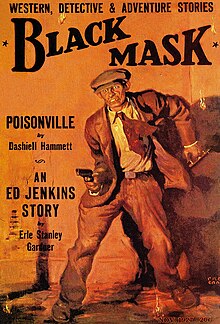Pulp magazines were inexpensive fiction magazines that were published from 1896 until around 1955. The term "pulp" derives from the wood pulp paper on which the magazines were printed, due to their cheap nature. In contrast, magazines printed on higher-quality paper were called "glossies" or "slicks". The typical pulp magazine had 128 pages; it was 7 inches (18 cm) wide by 10 inches (25 cm) high, and 0.5 inches (1.3 cm) thick, with ragged, untrimmed edges. Pulps were the successors to the penny dreadfuls, dime novels, and short-fiction magazines of the 19th century.
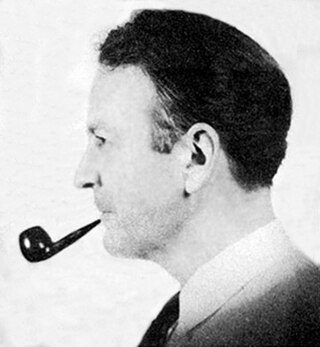
Raymond Thornton Chandler was an American-British novelist and screenwriter. In 1932, at the age of forty-four, Chandler became a detective fiction writer after losing his job as an oil company executive during the Great Depression. His first short story, "Blackmailers Don't Shoot", was published in 1933 in Black Mask, a popular pulp magazine. His first novel, The Big Sleep, was published in 1939. In addition to his short stories, Chandler published seven novels during his lifetime. All but Playback have been made into motion pictures, some more than once. In the year before his death, he was elected president of the Mystery Writers of America.
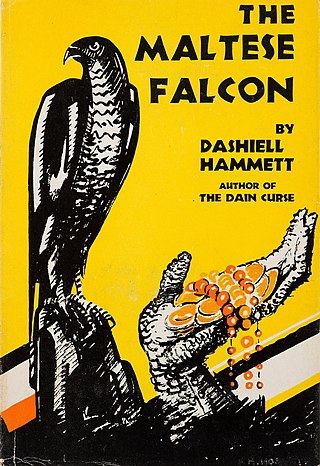
The Maltese Falcon is a 1930 detective novel by American writer Dashiell Hammett, originally serialized in the magazine Black Mask beginning with the September 1929 issue. The story is told entirely in external third-person narrative; there is no description whatsoever of any character's thoughts or feelings, only what they say and do, and how they look. The novel has been adapted several times for the cinema.

Samuel Dashiell Hammett was an American writer of hard-boiled detective novels and short stories. He was also a screenwriter and political activist. Among the characters he created are Sam Spade, Nick and Nora Charles, The Continental Op and the comic strip character Secret Agent X-9.

Ellery Queen is a pseudonym created in 1928 by the American detective fiction writers Frederic Dannay (1905–1982) and Manfred Bennington Lee (1905–1971). It is also the name of their main fictional detective, a mystery writer in New York City who helps his police inspector father solve baffling murder cases. From 1929 to 1971, Dannay and Lee wrote around forty novels and short story collections in which Ellery Queen appears as a character.

Mystery is a fiction genre where the nature of an event, usually a murder or other crime, remains mysterious until the end of the story. Often within a closed circle of suspects, each suspect is usually provided with a credible motive and a reasonable opportunity for committing the crime. The central character is often a detective, who eventually solves the mystery by logical deduction from facts presented to the reader. Some mystery books are non-fiction. Mystery fiction can be detective stories in which the emphasis is on the puzzle or suspense element and its logical solution such as a whodunit. Mystery fiction can be contrasted with hardboiled detective stories, which focus on action and gritty realism.

Black Mask was a pulp magazine first published in April 1920 by the journalist H. L. Mencken and the drama critic George Jean Nathan. It is most well-known today for launching the hardboiled crime subgenre of mystery fiction, publishing now-classic works by Dashiell Hammett, Raymond Chandler, Erle Stanley Gardner, Cornell Woolrich, Paul Cain, Carroll John Daly, and others.
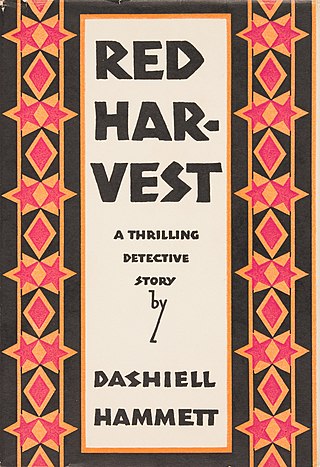
Red Harvest (1929) is a novel by American writer Dashiell Hammett. The story is narrated by the Continental Op, a frequent character in Hammett's fiction, much of which is drawn from his own experiences as an operative of the Pinkerton Detective Agency. The plot follows the Op's investigation of several murders amid a labor dispute in a corrupt Montana mining town. Some of the novel was inspired by the Anaconda Road massacre, a 1920 labor dispute in the mining town of Butte, Montana.
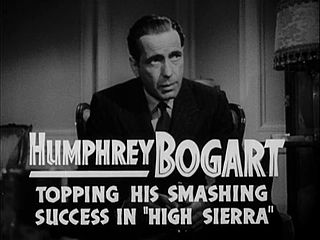
Sam Spade is a fictional character and the protagonist of Dashiell Hammett's 1930 novel The Maltese Falcon. Spade also appeared in four lesser-known short stories by Hammett.
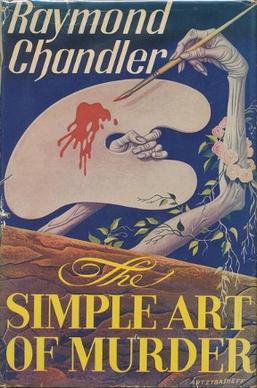
The Simple Art of Murder is the title of several quasi-connected publications by hard-boiled detective fiction author Raymond Chandler:
Hardboiled fiction is a literary genre that shares some of its characters and settings with crime fiction. The genre's typical protagonist is a detective who battles the violence of organized crime that flourished during Prohibition (1920–1933) and its aftermath, while dealing with a legal system that has become as corrupt as the organized crime itself. Rendered cynical by this cycle of violence, the detectives of hardboiled fiction are often antiheroes. Notable hardboiled detectives include Dick Tracy, Philip Marlowe, Nick Charles, Mike Hammer, Sam Spade, Lew Archer, Slam Bradley, and The Continental Op.

The Glass Key is a novel by American writer Dashiell Hammett. First published as a serial in Black Mask magazine in 1930, it then was collected in 1931. It tells the story of a gambler and racketeer, Ned Beaumont, whose devotion to Paul Madvig, a crooked political boss, leads him to investigate the murder of a local senator's son as a potential gang war brews. Hammett dedicated the novel to his onetime lover Nell Martin.

The Dain Curse is a novel by American writer Dashiell Hammett, published in 1929. Before its publication in book form, it was serialized in Black Mask magazine in 1928 and 1929.
Carroll John Daly (1889–1958) was a writer of crime fiction. One of the earliest writers of hard-boiled fiction, he is best known for his detective character Race Williams, who appeared in a number of stories for Black Mask magazine in the 1920s.
The Gutting of Couffignal (1925) is a hardboiled crime short story by Dashiell Hammett. It has been reprinted many times in different collections, namely: The Return of the Continental Op,The Big Knockover,Crime Stories and Other Writings, and The Big Book of the Continental Op.
George Caryl Sims, better known by his pen names Paul Cain and Peter Ruric, was an American pulp fiction author and screenwriter. He is best known for his novel Fast One, which is considered to be a landmark of the pulp fiction genre and was called the "high point in the ultra hard-boiled manner" by Raymond Chandler. Lee Server, author of the Encyclopedia of Pulp Fiction Writers, called Fast One "a cold-hearted, machine-gun-paced masterwork" and his other writings "gemlike, stoic and merciless vignettes that seemed to come direct from the bootlegging front lines."
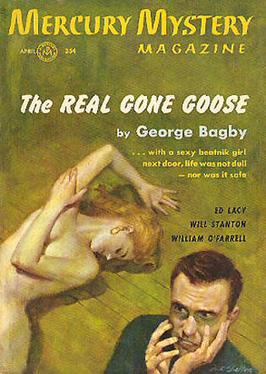
Mercury Publications was a magazine publishing company,initially owned and operated by Lawrence E. Spivak, which mainly published genre fiction in digest-sized formats. The focus of Spivak's line was on detective and mystery stories and novels, but it also included magazines about humor, fantasy, and true crime. The offices were located at 570 Lexington Avenue in New York, NY and in later years in Cornwall, Connecticut.
Raoul Whitfield was an American writer of adventure, aviation, and hardboiled crime fiction. During his writing career, from the mid-1920s to the mid-1930s, Whitfield published over 300 short stories and serials in pulp magazines, as well as nine books, including Green Ice (1930) and Death in a Bowl (1931). For his novels and contributions to the Black Mask, Whitfield is considered one of the original members of the hard-boiled school of American detective fiction and has been referred as "the Black Mask's forgotten man".
Stephen Gould Fisher was an American author best known for his pulp stories, novels and screenplays. He is one of the few pulp authors to go on to enjoy success as both an author in "slick" magazines, such as the Saturday Evening Post, and as an in-demand writer in Hollywood.
"The House in Turk Street" is an early short story by Dashiell Hammett, featuring the Continental Op. It was first published in Black Mask in April 1924. This story indicates Hammett was turning towards themes of increasing violence in his stories, and its savagery has been commented upon, particularly the massacre which occurs at the end.

